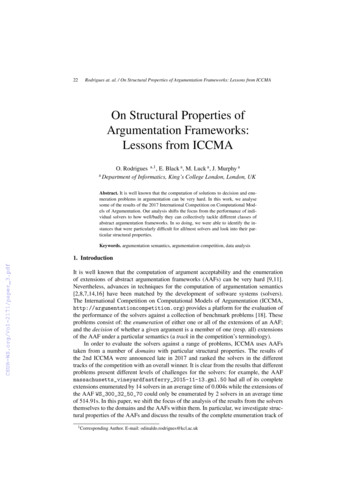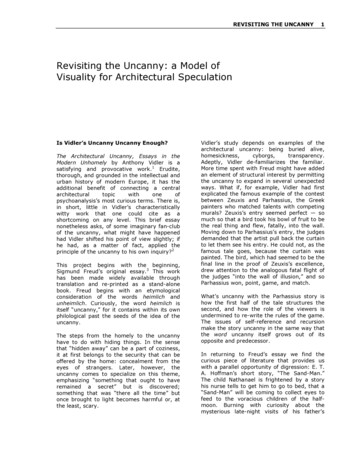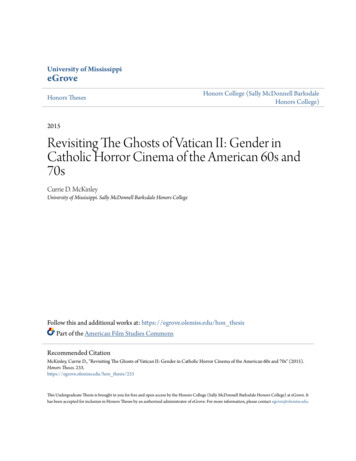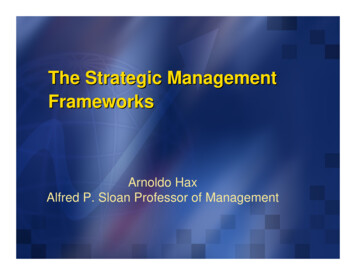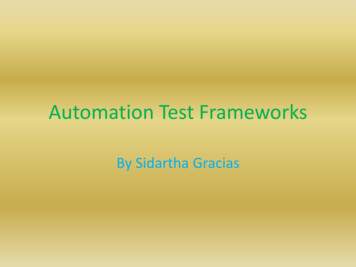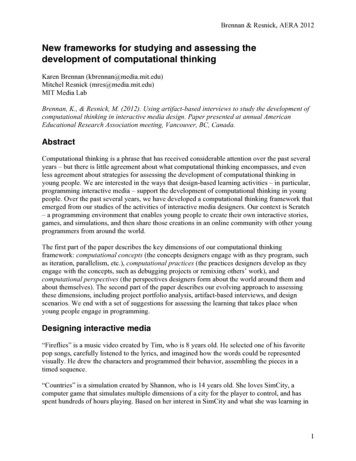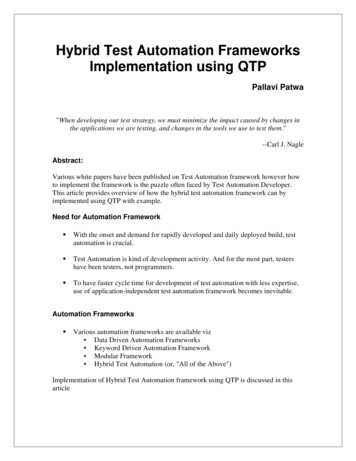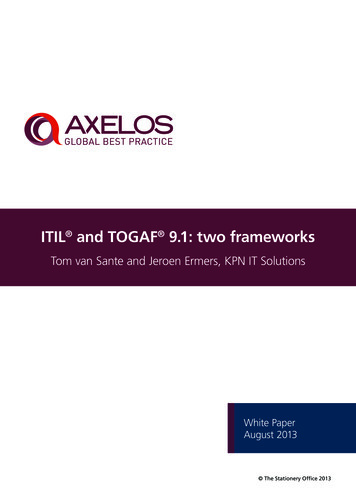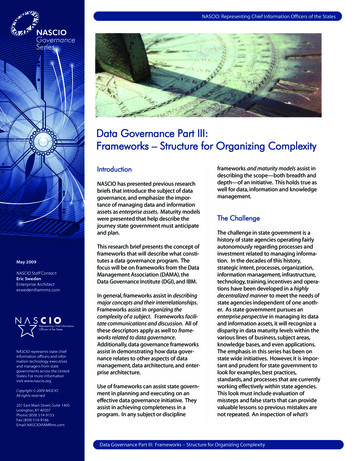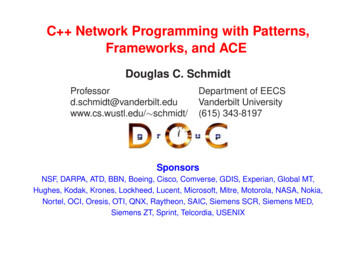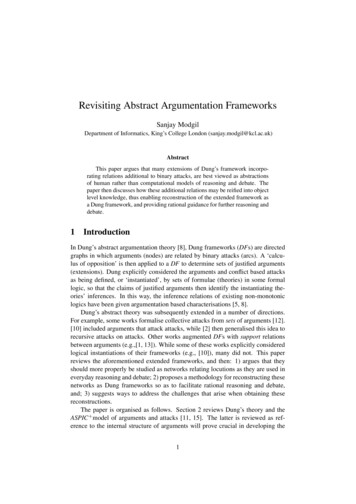
Transcription
Revisiting Abstract Argumentation FrameworksSanjay ModgilDepartment of Informatics, King’s College London (sanjay.modgil@kcl.ac.uk)AbstractThis paper argues that many extensions of Dung’s framework incorporating relations additional to binary attacks, are best viewed as abstractionsof human rather than computational models of reasoning and debate. Thepaper then discusses how these additional relations may be reified into objectlevel knowledge, thus enabling reconstruction of the extended framework asa Dung framework, and providing rational guidance for further reasoning anddebate.1IntroductionIn Dung’s abstract argumentation theory [8], Dung frameworks (DFs) are directedgraphs in which arguments (nodes) are related by binary attacks (arcs). A ‘calculus of opposition’ is then applied to a DF to determine sets of justified arguments(extensions). Dung explicitly considered the arguments and conflict based attacksas being defined, or ‘instantiated’, by sets of formulae (theories) in some formallogic, so that the claims of justified arguments then identify the instantiating theories’ inferences. In this way, the inference relations of existing non-monotoniclogics have been given argumentation based characterisations [5, 8].Dung’s abstract theory was subsequently extended in a number of directions.For example, some works formalise collective attacks from sets of arguments [12].[10] included arguments that attack attacks, while [2] then generalised this idea torecursive attacks on attacks. Other works augmented DFs with support relationsbetween arguments (e.g.,[1, 13]). While some of these works explicitly consideredlogical instantiations of their frameworks (e.g., [10]), many did not. This paperreviews the aforementioned extended frameworks, and then: 1) argues that theyshould more properly be studied as networks relating locutions as they are used ineveryday reasoning and debate; 2) proposes a methodology for reconstructing thesenetworks as Dung frameworks so as to facilitate rational reasoning and debate,and; 3) suggests ways to address the challenges that arise when obtaining thesereconstructions.The paper is organised as follows. Section 2 reviews Dung’s theory and theASPIC model of arguments and attacks [11, 15]. The latter is reviewed as reference to the internal structure of arguments will prove crucial in developing the1
above mentioned argument and methodology, and ASPIC provides a general account of the structure of arguments that has been shown to capture many existingapproaches to argumentation. Sections 3.1 and 3.2 then review the above mentioned extensions, and argue that the additional abstract relations that many ofthese frameworks introduce are not warranted by logical instantiations. This isbecause they either fail to meaningfully abstract from underlying logical concepts,or because the interpretation of these additional abstract relations suggest that theirlogical instantiations can be used to reconstruct Dung frameworks. This critiquethen leads to the development of two lines of argument explored in Sections 3.3 and3.4. Firstly, if the underlying logical instantiations of extended frameworks giverise to Dung frameworks that preserve the intended meaning of the additional abstract relations, then acceptability semantics defined for the extended frameworksshould yield justified arguments that correspond to the justified arguments yieldedby the reconstructed Dung frameworks. I show that in some cases these correspondences fail. Secondly, extended frameworks should more properly be motivatedas networks that relate locutions as they are used and related in everyday reasoning and debate. These two lines of argument then lead Section 4’s proposal thatthese networks be mapped to a computational model of structured arguments – theASPIC model – and subsequently reconstructed as Dung frameworks in whichthe evaluated status of arguments provides feedback to users. In generating thesereconstructions, one needs to ‘reifiy’ the abstract relations into the object levelknowledge that these relations implicitly encode. However, multiple such reifications, and thus multiple reconstructed Dung frameworks, are possible. I thereforeconclude by suggesting how reasoning and dialogue can be guided in order to resolve uncertainties as to what are the intended reifications. Users can be promptedto reveal the implicit knowledge encoded in the relations they assert as holding,and in so doing both enable reconstruction of Dung frameworks, and render suchknowledge explicit and available for use in further reasoning and debate.22.1BackgroundDung’s theory of argumentationA Dung argumentation framework (DF ) is a pair (A, R), where R A A is anattack relation on the arguments A. Then:Definition 1 S A is conflict free iff no two arguments in S attack each other.For any S A, X is acceptable w.r.t. S iff for every Y that attacks X, there is aZ S that attacks Y (in which case Z is said to defend or ‘reinstate’ X). Then forany conflict free S A, S is an extension that is :– admissible if every argument in S is acceptable w.r.t. S;– complete if it is admissible and every argument acceptable w.r.t. S is in S;– preferred if it is a maximal under set inclusion complete extension;– grounded if it is the minimal under set inclusion complete extension;2
– stable if preferred. and every argument not in S is attacked by an argument in S.The justified arguments of (A, R) under semantics T {preferred, grounded,stable} are those arguments in every T extension.2.2Arguments and attacks in the ASPIC frameworkThe remainder of this paper assumes arguments are structured as in the ASPIC framework [11, 15]; i.e., as trees whose leaf nodes are premises in a given knowledge base, and whose non-leaf nodes N are either defeasible or strict inferencerules of the form φ1 , . . . , φn 1 φn , respectively φ1 , . . . , φn 1 φn , wherefor i 1 . . . n 1, N has a child node Ni that is either a premise φi , or a strict ordefeasible rule with conclusion φi . Note that a premise (node) is itself an argument.A0 is then a sub-argument of A if A0 is a sub-tree of A (including the case that0A is a leaf node (premise)). Note that A is a sub-argument of itself, whereas propersub-arguments of A are sub-arguments of A excluding A itself. For simplicity Iwill in the remainder of this section only consider arguments with defeasible rules.Figure 1 shows four arguments B, C, D and E. Note the argument B with subarguments B, B1, B2, and B3.The claim of an argument A, denoted Claim(A), is φ if A’s root node is arule with consequent φ, or A is a single node (premise) φ. We also say that Aforward-extends B on φ, equivalently B backward extends A on φ, if B is a propersub-argument of A, and Claim(B) is φ. Finally, Concs(A) denotes the claimsof all sub-arguments of A. For example, in Figure 1, Concs(B) {f, b, w, q}.Definition 2 A attacks B on φ, if Claim(A) is the negation of some φ such that: φ Concs(B) (i.e., φ is a premise or consequent of a defeasible rule in B), or: φ is a name (a constant in the object level language) assigned to a defeasibleinference rule in B (A is then said to ‘undercut’ B ).Figure 1 shows examples of attacks, from E, C and D, to B. Note that [11, 15]prohibits attacks on any φ that is the conclusion of a strict inference rule, since asfirst shown in [7], this leads to violation of rationality postulates for argumentation.The generality of ASPIC accounts for this paper’s assumption that argumentsand attacks conform to the ASPIC model. One is free to choose the strict and defeasible inference rules, and the object level language in which wff φ are expressed.For example defeasible rules may be domain specific (akin to Reiter’s defaultrules), such as bird(X) f ly(X), so that given the premise bird(tweety) an argument with root node bird(tweety) f ly(tweety) claims f ly(tweety). Suchrules may also be domain independent, e.g., defeasible modus ponens: φ, φψ ψ ( being the defeasible implication connective in the object level language). Then, given premises bird(tweety), bird(X)f ly(X), we have anargument claiming f ly(tweety), with root node: ‘bird(tweety), bird(tweety)f ly(tweety) f ly(tweety)’ .3
r4 : pCBDr1 : b) r1)fr3 : pB1r2 : w, qp wE)bwqB2B3) fpFigure 1: Propositions b, f, w, q, p respectively denote that Tweety is a bird, f lies,has wings, quacks, and is a penguin. ri , i 1 . . . 4, are propositions naming rules.Note that [11, 15] also generalise the notion of negation allowing one to specifythat a wff is a contrary of another wff ( is then a special case, i.e., φ is a contrary ofψ whenever ψ is of the form φ or φ is of the form ψ). It is this notion of contrarythat [11, 15] refer to when defining attacks. [11, 15] then show that many logicalinstantiations of Dung frameworks and other general structured approaches to argumentation can be formalised as instances of the ASPIC framework, in the sensethat the arguments and attacks they define are special cases of ASPIC argumentsand attacks. For example, classical logic instantiations of Dung frameworks, wherepremises may be taken from a knowledge base of classical wff, and arguments areconstructed using only strict classical inference rules (e.g., modus ponens etc).3Abstract Argumentation Frameworks: Acceptability Semantics and InstantiationsThis section reviews examples of abstract argumentation frameworks (AAF s) thatextend DF s with support and variants of binary attack relations. I will assume that,as in the case of DF s, these AAF s are instantiated by underlying logical theories.I then argue that in cases where abstract level relations are meaningful abstractionsof underlying logical relations, one can reconstruct DF s from the underlying theories. I then conclude that : 1) the reconstructions shed light on how evaluationof the justified arguments in the AAF s may need to be modified; 2) AAF s shouldmore properly be viewed as modelling human reasoning and debate, rather than asabstractions of underlying theories in some formal logic.3.1Support RelationsI begin by considering frameworks with support relations. [1]’s bipolar argumentation framework (BAF) is of the form (A, Ratt , Rsupp ), where Rsupp is a support4
relation and Ratt an attack relation ([1] call Ratt a ‘defeat relation’,). The question arises as to what these support relations abstract from, in the sense that if Aattacks B on φ, then the attack abstracts from the object level logical relationship of negation relating Claim(A) and φ. [1] explicitly answer this questionfor specific kinds of arguments of the form (H, h) where H is a set of consistentclassical wff (premises) that minimally (under set inclusion) classically entail h.Then (H, h) supports (H 0 , h0 ) if h H 0 or h h0 . Generalising this notion toASPIC arguments:A supports B on φ if Claim(A) φ, φ Concs(B).BB1*r1 : b)fB1h) w)bwqB2B3r2 : w, qh) whr3 : n, kn)f)bqB3hAABAB2*)br1 : b)fB1kr1 : b)fAr2 : w, qwb))br3 : n, kqnB1'r2 : w, q)bkB1'*)br2 : w, q)bwwc)r1 : bB1r2 : w, qa)S1AFigure 2: Support relations are represented as lines with swollen ends. Note thatn, k, h respectively denote that Tweety builds nests, has a beak, and is feathered.Figures 2-a) and 2-b) respectively show an ASPIC argument A supporting Bon w and b. That S1 is the intended interpretation of support is further testified5
to by the motivating example dialogues in [1], e.g., in Example 6 in [1], F ‘Iconcerns a problem of public health, so I is important information’ supports A ‘I is important information, so we must publish it’. However, this interpretationof support then implies that if X supports Y on φ, then X backward extends Yon φ to define another argument Y . This is illustrated in Figures 2-a) and 2-b): A backwards extends B on w and b respectively, so that one can ‘reconstruct’arguments B1 and B2 . In other words, given the same logical information, onecan instantiate a DF consisting only of arguments and binary attacks.Consider another example of support relations in [14], in which the ‘argument’X “The bridge should be built where slow water exists without mud (i.e.at x,y)”is said to be supported by the argument B “Our historic survey says that slowwater exists at coordinates x,y”. Firstly, note that X is a rule rather than an argument, with consequent “The bridge should be built at x,y” and antecedent “slowwater exists without mud at x,y”. Then B supports X in the sense that X extendedwith the premise B, on its antecedent, yields an argument. This suggest a seconddistinct notion of support :A supports B on φ if Claim(A) φ, φ is in the antecedent of a rule in B.S2B10Figure 2-c) illustrates S2-support: A supportson w, so that one can re0 construct B1 . The example shows that s2-support does not always licence thereconstruction of arguments from the underlying logical information; B10 is notan argument, rather it is a rule in need of a supporting argument (for q). On theother hand, in [14]’s example above, B fully supports X, enabling reconstructionof an argument.3.2Attack Relations[12] and [4] extend DFs with collective attacks. In particular, in [12], individualarguments can be attacked by non-empty sets of arguments:Definition 3 A Dung framework with collective attacks (AFc ) is a tuple (A, Rc )where A is a set of arguments, and Rc (2A \ ) A . Then: S A is conflict free iff S 0 S, X S such that (S 0 , X) Rc . X is acceptable w.r.t. S A iff A0 A such that (A0 , X) Rc , S 0 Ssuch that (S 0 , Y ) Rc for some Y A0 .The extensions of an AFc are then defined as in Definition 1. [12]’s motivatingexample considers arguments A1 Joe does not like Jack and A2 There is a nailin Jack’s antique coffee table collectively attacking B Joe has no arms, so Joecannot use a hammer, so Joe did not strike a nail into Jack’s antique coffee table.Quoting from [12], A1 and A2 “jointly provide a case for the conclusion that Joehas a struck a nail into Jack’s antique coffee table”. This implies that the collectiveattack is an abstraction of a rule relating the claims of A1 and A2 to the negationof the claim of B. This suggests we can reconstruct a DF , given that A1 and A2can be extended with a rule ‘If Joe does not like Jack and there is a nail in Jack’s6
a)A4j, n!sjnr2 : j , n)sBA2nr1 :r3 : h a) s) aA3 hjA5r2 : j , n , jJoe did not strike a nail intoJack's antique coffee table (Ls)Joe does not like Jack (Lj)njn nsjvjvA1)sn sJoe cannot use a hammer (Lh)There is a nail in Jack'santique coffee table (Ln)Joe has no arms (La)b)PPr p : bob likes skiingNGC)rg r cbob likes skiingFigure 3: a) Natural language representation of locutions Lj, Ln, La, Lh, Ls involved in a collective attack are shown, with the corresponding logical formulationof the collective attack from {A1, A2} to B, and three possible reconstructed arguments A3, A4 and A5 based on the collective attack. b) shows a preference attackon an attack (P), and a recursive attack on an attack (N)antique coffee table then Joe has a struck a nail into Jack’s antique coffee table’ todefine an argument A that directly attacks B on its conclusion. In general:Definition 4 Let X1 , . . . , Xn collectively attack Y on φ (φ Concs(Y ) or φnames a defeasible inference rule in Y ). Then:reconc ({X1 , . . . , Xn }, φ) is the argument X, whose root node is the defeasible rule Claim(X1 ), . . . , Claim(Xn ) φ, backward extended by argumentsX1 , . . . , Xn , such that X attacks Y on φ.Figure 3-a) illustrates, showing how A3 reconc ({A1, A2}, s) is backwardextended by A1 and A2. A3 then attacks B on s.While [12] acknowledge that collectively attacking arguments can be extendedto single arguments which then attack their target, they maintain that collective7
attacks are still warranted by logical instantiations, since (referring Figure 3-a)it may be that A1 or A2 are attacked, but A3 is not attacked. But a structuredaccount of argumentation shows this cannot be the case. Recalling Definition 2, anargument is attacked if any of its sub-arguments are attacked, so that if A1 or A2are attacked then A3 is attacked (on its sub-arguments A1 or A2).Now note that for frameworks with support relations, the logical informationyielding a BAF will yield exactly one reconstructed DF . However, the logicalinformation yielding an AFc may yield many DF s. This is because the same collective attack may abstract from different underlying logical instantiations. Forexample, we have thus far ignored arguments containing strict inference rules,but reconc ({X1 , . . . , Xn }, φ) might be defined to yield arguments with top nodesClaim(X1 ), . . . , Claim(Xn ) φ (argument A4 in Figure 3-a)) or argumentswith additional premises together with domain independent inference rules (A5 inFigure 3-a)). I comment further on this issue in Section 4.A number of works extend DF s with attacks on attacks. In [10]’s ExtendedArgumentation Frameworks (EAFs), an argument P claiming a preference for Gover its attacker C, attacks the attack from C to G, so that the success of C’s attackon G is denied, and G is justified (Fig.3-b). For example, G ‘Bob want to goto Gstaad since there is a last minute offer for Gstaad’ symmetrically attacks C ‘Bob want to go to Cuba since there is a last minute offer for Cuba’. Then Pexpresses Bob’s preference for G over C given that Bob likes skiing and so prefersski resorts.[10] explicitly studied logical instantiations of EAFs, where argumentsexpressing preferences are instantiated by premises and rules concluding prioritiesover rules in the arguments over which the preferences are claimed. For example,P might be an argument with the premise ‘Bob likes skiing’ and defeasible rule rpconcluding that the rule rg in G has greater priority than the rule rc in C.[2] then generalised EAFs to recursive attacks on attacks. For the example inFigure 3-b), [2] suggest that N ‘there have been no snowfalls in Gstaad for amonth so it is not possible to ski in Gstaad’ attacks the preference attack from P .However, unlike P , it is difficult to conceive of a logical instantiation yielding anargument N that claims a preference for an attack C G over the argument P .Indeed, one might intuitively consider N as claiming rp , so undercutting P onits rule, since not being able to ski in Gstaad denies the defeasible inference stepfrom Bob likes skiing, to a preference for (the rule in) G over (the rule in) C.Finally, note that while recursive attacks do not seem well motivated from a logicalinstantiation perspective, I will in Section 3.4 suggest an alternative motivation.3.3Acceptability Semantics for Abstract Argumentation FrameworksThe previous section’s discussion suggests that if AAF s such as bipolar frameworks (BAF s) and frameworks with collective attacks (AFc s) can be reconstructedas Dung frameworks, then one would expect a correspondence between the statusof arguments in the AAF s and their status in the reconstructed DF s.Firstly, consider that if A supports B, and B symmetrically attacks C, then the8
preferred extensions defined in [1] are {A, B} and {C}, since [1] suggest that sinceA supports B and B attacks C then there is a supported attack from A to C, andso {A, C} is not conflict free. Suppose now we have the ASPIC arguments1 A [p; p q], B [q; q t], C [ t], where A supports B on the premise q. Thenwe can reconstruct the additional argument B [p; p q; q t] which alsosymmetrically attacks C. The preferred extensions of the reconstructed DF are{A, B, B } and {C, A} (ignoring arguments [p] and [q] which are irrelevant to theanalysis). Thus the expected correspondence does not hold, since A is justified in inthe reconstructed DF , but A is not justified in the original BAF . The discrepancyarises because it seems that in the abstract BAF , A is assumed to support B on itsclaim, in which case a correspondence would then hold, since in the re
3 Abstract Argumentation Frameworks: Acceptability Se-mantics and Instantiations This section reviews examples of abstract argumentation frameworks (AAFs) that extend DFs with support and variants of binary attack relations. I will assume that, as in the case of DFs, these AAFs
